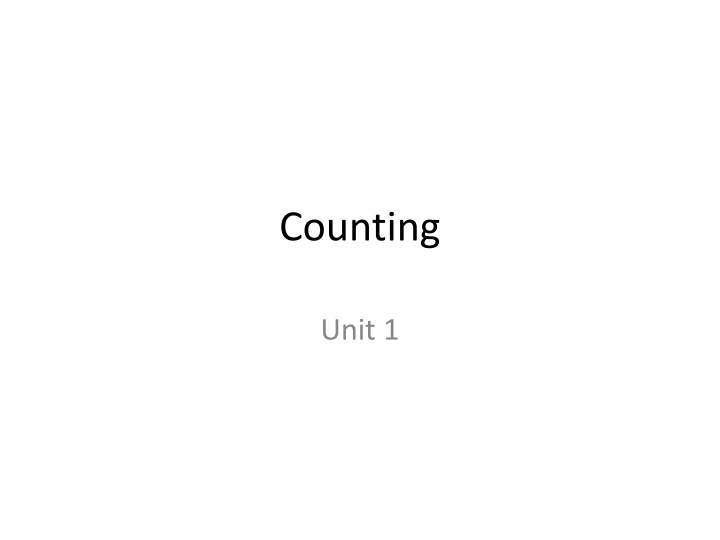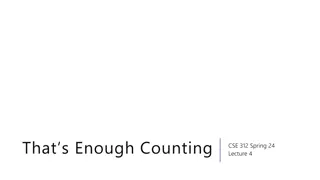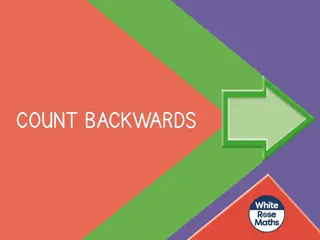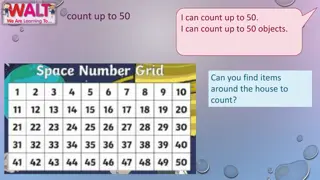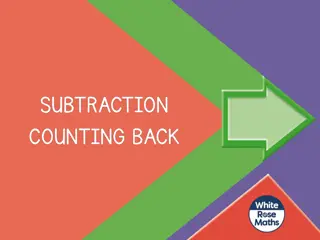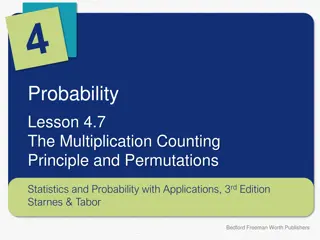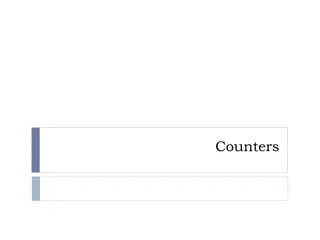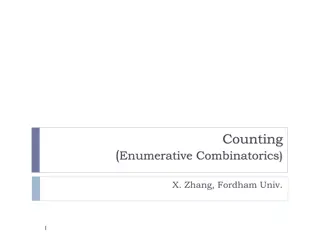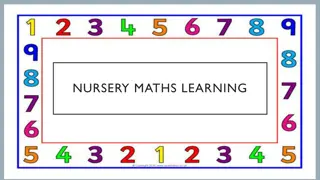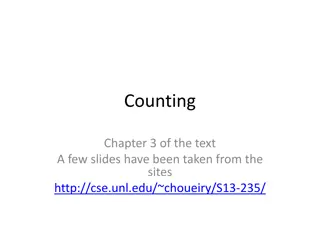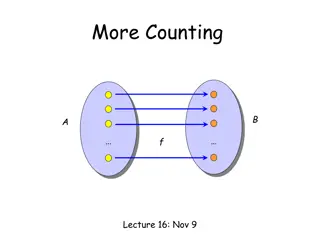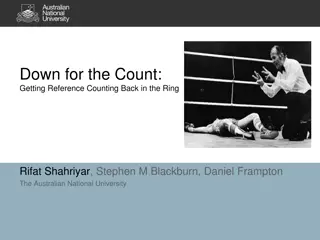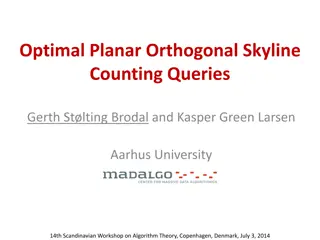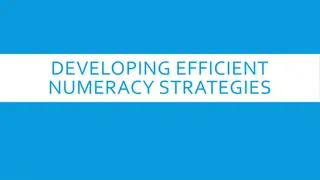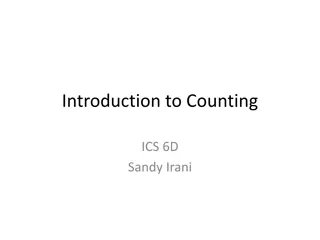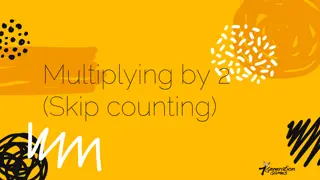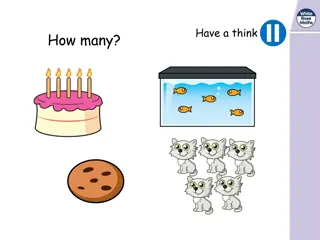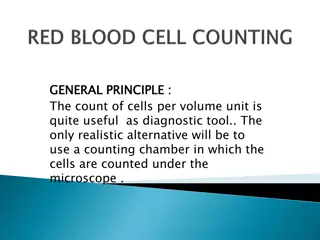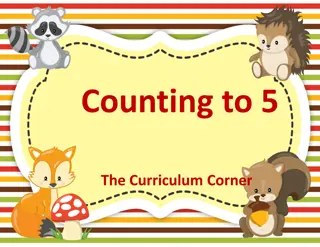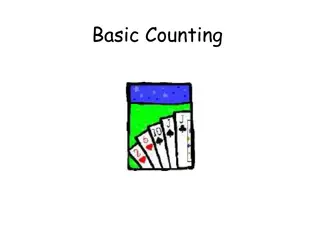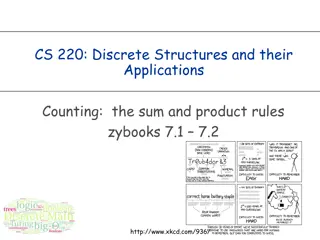Counting Principles Through Fun Activities
Explore the concept of counting through various activities like coin flips, sandwich making, and golf orderings. Learn how to use tree diagrams for counting different outcomes and understand the multiplication principle to calculate total possible combinations. Engage with engaging examples like flipping coins, making sandwiches with different ingredients, and choosing golf playing orders with friends.
Download Presentation

Please find below an Image/Link to download the presentation.
The content on the website is provided AS IS for your information and personal use only. It may not be sold, licensed, or shared on other websites without obtaining consent from the author.If you encounter any issues during the download, it is possible that the publisher has removed the file from their server.
You are allowed to download the files provided on this website for personal or commercial use, subject to the condition that they are used lawfully. All files are the property of their respective owners.
The content on the website is provided AS IS for your information and personal use only. It may not be sold, licensed, or shared on other websites without obtaining consent from the author.
E N D
Presentation Transcript
Counting Unit 1
Counting Activity 1 1. Let H be heads and T be tails. How many different results can we get from 1 flip of the coin?
Counting Activity 2 1. How many different results can we get from two flips? How about three? 2. We call each flip an event. An event is a discrete activity, sometimes each event takes place at different times or sometimes the events can take place at the same time. In the case of our coin flips, each flip is considered an event. 3. The flip of a coin is also called a discrete event because we can t have a half or a quarter of a coin flip.
Counting Activity 3 1. Using a tree diagram to help with counting? a. For each event we will use a a branch of the tree. b. Each possible result will be a limb on the branch. c. We count the total number of limbs on the final branch of the tree. 2. Suppose that you own a sandwich shop, you have two kinds of bread (wheat and white), three kinds of cheese(cheddar, swiss, mozarella), and four kinds of meat(roast beef, turkey, chicken, ham). How many different kinds of sandwiches could you make?
Counting Activity 3 Roast Beef Chicken Cheddar Turkey Ham Roast Beef Chicken Swiss Turkey White Ham Roast Beef Chicken Mozarella Turkey Ham Sandwiches Roast Beef Chicken Cheddar Turkey Ham Roast Beef Chicken Swiss Wheat Turkey Ham Roast Beef Chicken Mozarella Turkey Ham
Counting Activity 4 Suppose that you and four friends wanted to play some golf. You need to choose an order to play in, 1 through 5. How many different orders can you play in? (Construct a tree diagram to show the different pairings.)
The Multiplication Principle Take a look at the tree diagram for Counting Activity 3. We have two different kinds of bread, three different kinds of cheese and four different kinds of meat, and 24 different kinds of sandwiches. That is: 2 x 3 x 4= 24. The multiplication principle tells us that if we have a certain number of elements of a group and we want to figure out the total number of groupings that we can get with these elements, then we multiply the number of each event by the number of the other events. That is called the multiplication principle. Kind of tricky to write down, but simple to put into practice!
Counting Activity 5 1. Suppose that you flip a coin 5 times, how many different results can you get for the group of 5 flips? 2. A straight in poker is when you have five consecutive cards, for example, two, three, four, five, six, of any suit (w call this a six high straight). There are four suits in a deck of cards (hearts, spades, clubs, and diamonds). How many ways can you get a ten high straight (six, seven, eight, nine and ten of any suit)? 3. In poker, a three of a kind is when you get three of the same number card (for example, the four of spades, the four of clubs, and the four of the diamonds). How many ways can you get three of a kind with kings?
Factorials Suppose there are five people who need to be placed in order from 1 to 5? How many ways can they be ordered? According to the multiplicative principle, we can count the total number by multiplying: 5 x 4 x 3 x 2 x 1=120 When you begin at a particular number and then multiply it by the next smallest number and then stop at 1, this is called a factorial and is written as 5!.
Factorials We write the factorial as 5!=120. You can find the factorial key in your calculator. On the scientific calculators, this is actually a key that you can shift to. On the TI-83, 84, and 84-Plus, you press the number (5) MATH-PROB-the factorial key looks like an exclamation point.
Repetitions How many different ways can we order the letters in the word Mississippi? We can t just use 11! because we have four choices for i, four choices for s, two choices for p and one m. We need to eliminate the counting for the redundant letters. We need to divide out the redundant letters. How many ways can we order the i s? The s s? The p s?
Repetitions For the total number of words we can make from Mississippi, we would use: 11! 4!*4!*2!=34,650
Permutations When we want to find out how many groups or results we can get when we have a specific number of elements and when each of the elements has a specific role or order then we use permutations. Permutations utilize the multiplicative principal in that we can think of the permutation as being the multiplication of individual events in descending order. For example suppose that we have five people that we want to put into a club s group of offices, president, vice-president, and secretary. How many groups of president, vice-president and secretary can we make with those five people?
Permutations Suppose that we have 5 people (Sally, Bobby, Juan, Theresa, and Luz) for each office we can have one person. For the president, we can choose from any of the five, for the second we can then choose four, and finally for the secretary we have three. Using the multiplicative principle, we get: 5 x 4 x 3=60
Permutations You can use your calculator in order to find permutations. On a standard scientific calculator. You will find on one of the shift keys, a key that says nPr or nPx. This is the permutation key. n is the number of elements (or people that you can choose from) and r or x is the number that you need in each group. So for this problem we would press 5 nPr 3. For a TI-83, 84, or 84-Plus MATH-PROB-and the button that says nPr. In the same way as the scientific calculator, 5 nPr 3 and enter.
Combinations Suppose that we wanted to figure out how many groups of elements we could get from a larger group if each of the elements did not have a set role or order. For example, suppose that you had 10 different kinds of jellybeans, how many different groups of three can you get from those 10 jellybeans?
Combinations Suppose that we tried to use the same technique as permutations. For the first jellybean we have 10 choices, for the second we have 9, and the third we have eight. Suppose that the first jellybean was cinnamon, the second jellybean was grape, and the third was licorice. This is one group. However, in this case, if licorice was the first, cinnamon was the second, and grape was the third, then this group is still the exact same group. In the case of our club committee, Juan as the president, Bobby as the vice- president, and Sally is the secretary is a different group from Bobby as the president, Sally as the vice-president, and Juan as the secretary. In the case of the jellybeans we can t use the permutation because we would be double- counting, we use a function called a combination.
Combination Unlike the permutation, we need to actually divide out the redundant groups. In the case of our jellybeans, how many redundant groups would we have from the cinnamon, licorice, and grape jellybeans? Using the multiplicative principle and factorials, we have: 3 x 2 x 1= 3!=6. So the total number of three jellybean groups that we can get from ten different jellybeans is: 10*9*8 3! =720 =120 6
Combinations We can use the calculator to find a combination. For a scientific calculator, there is a shift key nCr that is similar to the permutation. n is the number of elements that we are choosing from and r is the number in each group. On the graphing calculator, TI-83, TI-84, TI-84 Plus, use MATH-PROB-nCr. So for the jellybean problem, we would use 10 nCr 3.
Choosing when to use Combinations or Permutations We say that we use a Permutation when order matters. When we use a Combination we say that order does not matter. Order mattering means that each element in a particular group has a particular role or order. Like the example where each member of the committee was either the president, vice- president, and secretary. Order not mattering is like the jellybean example where the three different jellybeans can be placed into any order.
Sample Spaces The set of all objects that we are counting or considering for a particular event or set of events is called the sample space. Counting the number of elements in the sample space is something that is used frequently in probability.
Review for Homework New Terms Event Discrete Sample Space Combination Permutation Key ideas and techniques Developing Tree Diagrams The Multiplicative Principle Factorials Combinations and Permutations
